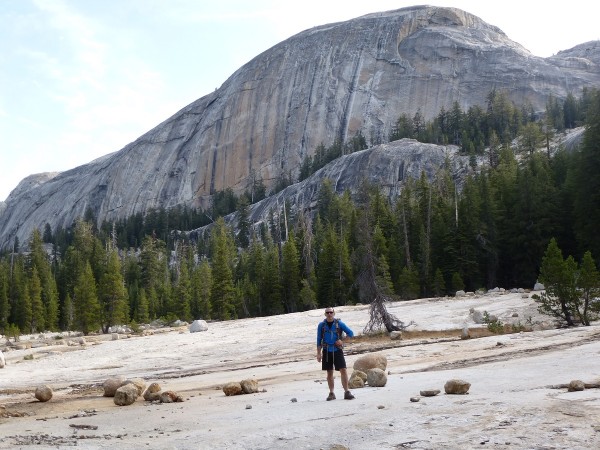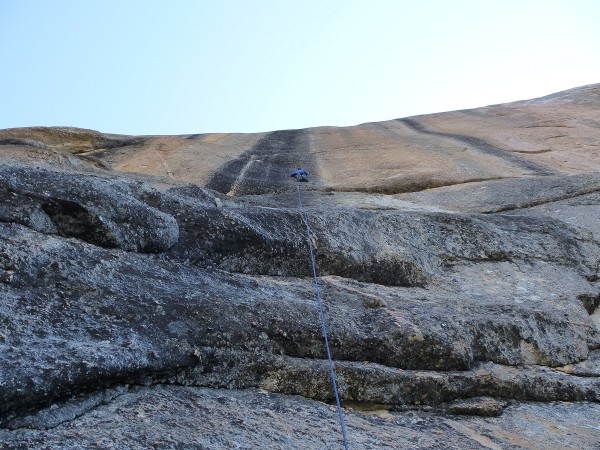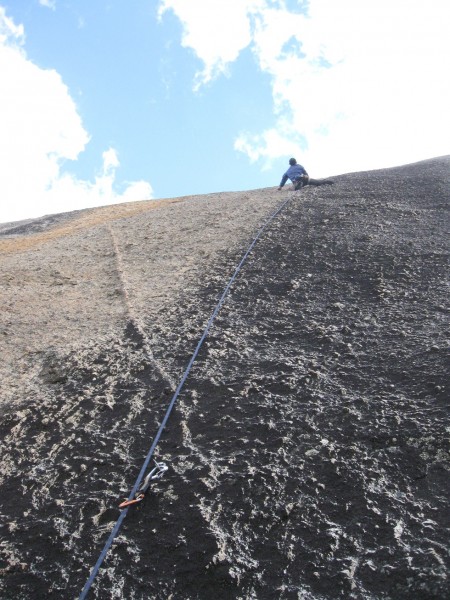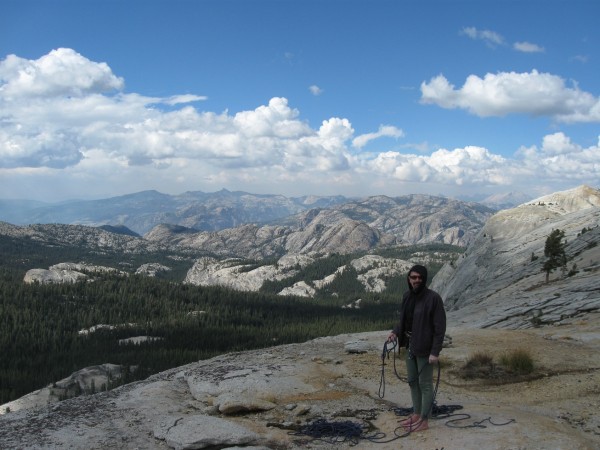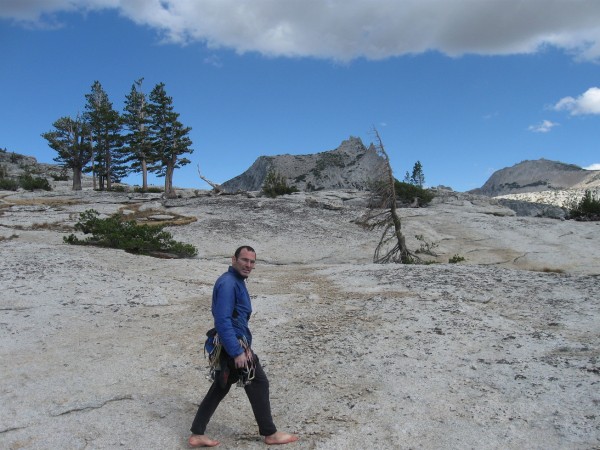I became aware of John Bachar in the winter of 2005/06. I had recently started climbing and bouldered poorly but enthusiastically in a Philadelphia gym a couple of times a week. While travelling on business I saw a
Rock and Ice magazine in the Seattle airport. It was titled “The Bouldering Issue.” Since I was a “boulderer” I picked up a copy. Through the cover piece I was introduced to John Bachar and although I’d only been climbing a short while, I was attracted to his ideas and attitudes about climbing. The article happened to mention his masterpiece the Bachar-Yerian on which only fifteen bolts (eight for belays) were placed on a roughly 500 foot face climb. Few other protection placements exist. At a rating of 11c X, I remember thinking, “That’s about V3. I climb V3 (in the gym) maybe I could climb that someday.” Since 2007 I’ve rarely climbed in the gym and have primarily focused on traditional climbs. I climb sport routes too, but prefer gear routes.
Fast forward to summer 2011 when I took my first trip to Tuolumne. By this time I was relatively well versed in the history of climbing and awed by the immense talent, refined skill, and mental toughness of the late master, John Bachar. I’d read his piece on the development of the Bachar-Yerian in the April 2009 issue of
The Alpinist countless times and studied the topos in guidebooks thousands more.
One day during that trip, my girlfriend and I headed up to Medlicott Dome to climb some of the routes off the Bachar-Yerian ledge and, of course, to take a look at the route. The wall is imposing, intimidating, and rather ominous. Having climbed a bunch of scary routes, I found the prospect of a clean ascent irresistible. Admittedly, I’m drawn to this type of climbing and decided that I’d tune up and take a run at it in 2012.
I planned to start specific training for the route in June 2012. Unfortunately, I got injured. I limped along for a week or so and realized I needed to take some time off. Over the course of the summer as I was returning to form, I started to think I might be able to pull it off. I was planning to visit my friend Todd in Bishop around Labor Day, so I asked him if he’d be interested in providing a belay. He said, “Sure, no problem.”
I spent two days climbing some easy stuff attempting to acclimate in Bishop Creek (elevation 9000 feet) and then rested the next day. On day four at elevation (I reside in Philadelphia, thirty-six feet above sea level) we headed up to Tuolumne. I remember having a sinking feeling in my stomach when we pulled into the parking area. It was cold and the warm-ups felt hard, not a good sign.
After a short break, I roped up for pitch one. I wandered up fifty feet of unprotected 5.9 knobs to where the wall steepens dramatically. The enormity of the wall set in and I began to feel like a bug. I got a cam in the horizontal at the top of the slab, reached up, and clipped the first bolt. After inspecting a possible path I cranked on some holds and fell. I chalked it up to a false start and tried again. The boulder problem went and soon I was clipping the second bolt. I then fell repeatedly. I eventually pulled through, sucking wind and seriously pumped. Downclimbing was out of the question, and with nowhere to rest I continued on. I over-gripped each hold in response to mounting fear. I found myself too high and right of the flake, got crossed up, and tried to correct my error. I barn-doored and peeled from the flake. I rotated out and away from the wall and crashed softly into the slab thirty-five feet below. I was a bit rattled, but unharmed. I lowered down to rest.
Refusing to acknowledge I was in over my head, I tied in again and climbed back to the headwall on pitch one. I fired the boulder problem and climbed somewhat smoothly to the flake. I placed a couple of cams and soon arrived at the belay, redpointing the pitch. I didn’t admit it out loud at the time, but I was wasted.
Todd came up to the belay, flaked the rope, and I soon set off on the infamous second pitch. The climbing starts up and right, then back left past a bolt four feet off the belay eventually weaving left of the black streak to a stance fifteen feet up. Every move felt hard and I was having trouble keeping my heart rate under control. From the stance there is a hard sequence moving up and right for a few body lengths before arriving at the first real bolt. The bolt off the belay doesn’t count for much other than preventing a factor two fall onto the belay.
I was over-gripping again and not using my feet well. A body length below the bolt I was totally maxed and knew that I was about to come off (not a pleasant feeling I can assure you). I rocketed past the belay, fortunately missed Todd, crashed into the wall, and smashed my right hip in the process. Todd got slammed into the wall as well. He didn’t say a word about it which is but one testament to what an awesome guy he is.
I’d previously taken a number of falls in the thirty foot range, but none were as fast, hard, and long as this one. There was no friction in the system to slow me down. I remember watching the rope at the belay paying out at high speed. It seemed it was happening in slow motion and I felt like the rope would never come tight. The result was a spectacular fifty foot free fall. I came to a stop dangling twenty-five feet below the pitch one belay.
I clambered back to the belay and took a breather. My obsession with sending the route was clouding my judgment. I headed back up. Again, Todd didn’t say a word. I quickly got to the stance out left and proceeded to shake out trying to get something back for what seemed like an hour. I cast off, stabbing at holds and squeezing them with everything I had. I arrived at the bolt shaking like a leaf. Selfishness had gotten the best of me. I was far from solid and if I’d fallen, I would have landed on Todd from thirty-five feet above. There are actually some good holds here, but I could barely hold on. I managed to clip the bolt and promptly took. I had nothing left and my muscles were reduced to non-responsive slurry. I finally came to my senses and we bailed. Upon reaching the ground, Todd dubbed the experience a “reconnaissance mission” with his usual dry sense of humor.
I was drained and depressed, but as early as the next day I still wanted to try again. Todd’s first email the following week ended with “BY 2013!”. I knew I’d need significantly more time at altitude and lots of time climbing knobs.
Throughout the winter of 2012 and well into 2013, I often replayed the first pitch moves in my mind while out for a run. If I could top out pitch one without expending too much energy, my chances would greatly improve. I imagined myself feeling solid on the second pitch. If I could make it up the overhanging sea of knobs intact, I knew I’d be able to send the final two pitches no matter how drained I was.
In July through mid-August of 2013 I tuned up at my local crags, climbing continuous laps on overhanging endurance routes as well as stacks of shorter power endurance routes. I pushed myself hard. I wanted to avoid getting pumped on the second pitch. In addition I wanted to have enough power on reserve in the event things got desperate.
On August 16th, I flew to Las Vegas with my girlfriend and drove to Bishop the next day. We spent a week in Tuolumne climbing knobs and acclimating to the altitude. She flew home on the 24th and I spent the next week commuting to Tuolumne from Bishop to climb more knobs. The attempt was planned for the following week.
Knob climbing is very specific, somewhat odd, and insecure. Route finding can be particularly challenging because everything looks like a hold. There are an infinite number of knobs, some of them can break, and many of them aren’t as good as they first appear. As a result, most of my time was spent at Medlicott and East Cottage Domes. I climbed the first pitch of the Bachar-Yerian a total of five times on two separate visits. At East Cottage Dome I climbed as many pitches back to back as I could handle.
My girlfriend Nancy, as well as new found friends Michael and Bibler, provided awesome belays and support during this time. Bibler delivered what I found to be a particularly amusing quote. Upon taking my 5.10 Moccasym slippers (not necessarily lauded as edging shoes) out of my climbing pack he said, “You’re going to climb the Bachar Yerian in
those?!”
At the end of the first two weeks I had the first pitch wired and was as fit as I’ve ever been. The time was well spent. I felt comfortable with the subtleties of knob climbing. I had three rest days planned which led to a fourth due to weather and smoke potential from the Rim Fire. Those four days dragged on and provided ample opportunity for doubt to creep into my mind.
The morning of September 4th finally came and I woke after a good night’s sleep. I was amped. We got to the parking area about 8 a.m. and were warmed up just shy of ten. There were a lot of darker clouds in the sky appropriately framing the task ahead, but no smoke to speak of. I tied in and quickly arrived at the boulder problem feeling fresh. There was a slight chill in the air, the crimps felt sharp, and some of the knobs felt slick. It didn’t matter. I had the moves wired and made it to the first belay moments later.
Todd came up and we got situated for pitch two almost a year to the day after 2012’s attempt. Suppressing doubt, I arrived at the stance up and left of the belay. It took awhile to get my breathing under control. I sussed the moves and committed, moving through the difficult sequence and arrived at bolt one. “Breath, relax, concentrate.” I was borrowing Bachar’s mantra described in his
Alpinist piece. I found a rhythm for my breath which helped to keep my heart rate down.
After a deep breath I started climbing again. Somewhere between bolt one and two, while in search of a foothold, I looked down and caught sight of the first bolt. It was waaay down below and made me shudder for a moment. The potential for a sixty foot fall was nauseating. One mistake and it would be reality. I didn’t allow my focus to drift. Instead I only looked a few feet left, right, up, or down in search of holds. This helped me create a comfortable zone to climb within and reduce the sequences to a move at a time.
I encountered some decent holds to shake out on before coming to a thin section ten feet below bolt two. I couldn’t hang out forever, but the sequence wasn’t entirely clear. Precise deliberate movement was an absolute necessity. With anxiety churning in my gut, I made a series of irreversible moves with no time to test the holds and was rewarded with a half pad incut hidden behind a knob. Grinning, I clipped the second bolt.
Eight feet higher I slipknotted a bomber knob and was able to shake yet again. I was actually able to enjoy the climbing at this point. However, I’d been on the pitch for nearly an hour and the pump was starting to build. The third bolt leads you back into the black streak occupied by a jumbled mix of solid and suspect knobs.
After another thirty foot runout and one last tricky sequence, I clipped the third bolt. Relief and excitement replaced fear and dread. The climbing eases a bit in the final ten to fifteen feet due to the appearance of some larger knobs. I reached the belay somewhat overwhelmed at having pulled off the best lead of my career. The elation would soon subside as more difficult and dangerous climbing lay ahead.
The third pitch starts off with a few thin, hard edging moves right off the belay. I thought there were supposed to be four bolts on the pitch, but there are only three. Similar to pitch two, the first bolt protects the belay. As a result, the first bolt is effectively forty feet up. Wandering 5.10 climbing got me there.
The sun had crested the west facing dome and was directly overhead making it difficult to scan for holds. Fortunately, clouds frequently provided cover. The climbing stiffened again as I approached the final bolt. Flaky rock was encountered in this section rattling my confidence a bit. My feet had been hurting for some time now and I was feeling worn down. There is a hard and insecure series of moves fifteen to twenty feet above the last bolt before you encounter better holds and a bomber cam placement. I bore down, cranked hard, and mercifully reached positive holds.
From beneath the horizontal I spotted a very old carabiner. I pulled up and saw two ancient opposed nuts. The humor of someone trying to place those nuts in the funky, flaring, knobby horizontal while likely gripped was not lost on me. I easily placed a few cams along the traverse enjoying the mellower climbing.
Looking up at the fourth pitch I was ready for some easier climbing as was advertised. Unfortunately, the first fifteen feet of the crack were awkward, harder than expected, and foreshadowed the nightmare finish that was to come.
After the initial difficulties, the crack does indeed ease up. Sixty feet higher the crack peters out and so does the pro. I was at a comfortable no hands stance fifteen feet out from my last good piece at a small left facing corner/flake. It would take gear, but I’d already dumped that piece forty feet lower. I tried to jam a carabiner in the crack with the idea of slinging and clipping it, but I couldn’t get it to hold. Instead, I mined out a cam placement in a sandy, shallow, and flaring horizontal to my left. I knew it was effectively worthless, but at least I didn’t have to carry it.
Unsure of where to head on the expansive upper dome, I climbed up and down, out right, back left and finally settled on climbing straight up from the corner/flake. Crumbly rock and highly suspect fractured knobs were encountered and avoided. I reached one final section of difficulty eighty feet out from my last piece. Wiping the grit from my feet after each step and using the most secure looking sloping knobs inset into the rock, I smeared and scratched my way to easy ground. I was at the end of my 70 meter rope (literally) and body belayed Todd up while positioned behind a medium sized, flat rock. Reaching the belay, we shook hands and regarding the final runout he remarked, “Holy mackanoli, what a cruel joke!”
Todd and I drank from pools of rain water on the summit and began the hike down soon after. We were both trashed and I was particularly fried from the non-stop climbing over serious terrain. I’m quite proud to have made a clean ascent of what I believe to be John Bachar’s signature test piece. I am humbled by the experience and by adding my name to the list of far more talented climbers who climbed this route before me.
Additional thoughts:
• The first pitch is closer to 12a than 11c. I’d split the difference and call it solid 11+
• While there is probably no move harder than 11a on the second pitch, the sustained difficulty is much harder than 11a
• Despite the moderate rating, the final pitch should not be taken lightly
Articles:
The Alpinist 29, April 2009
John Bachar’s account of the first ascent
Related links:
http://www.supertopo.com/climbers-forum/1045687/Bachar-Yerian-timelinep-who-did-which-ascent-and-when
http://www.supertopo.com/climbers-forum/375380/Bachar-Yerrian
Cool videos:
Ascent by Andrew Rock and Jan McCollum
http://vimeo.com/14878084
Ascent by Hayden Kennedy and Ivo Ninov
http://vimeo.com/6102968
